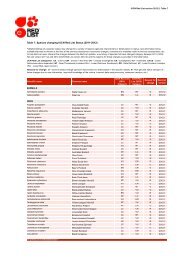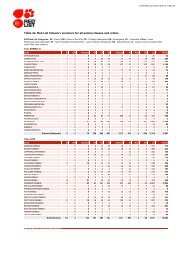IUCN Red List Guidelines - The IUCN Red List of Threatened Species
IUCN Red List Guidelines - The IUCN Red List of Threatened Species
IUCN Red List Guidelines - The IUCN Red List of Threatened Species
You also want an ePaper? Increase the reach of your titles
YUMPU automatically turns print PDFs into web optimized ePapers that Google loves.
<strong>Red</strong> <strong>List</strong> <strong>Guidelines</strong> 26<br />
<strong>of</strong> life history, habitat biology, pattern <strong>of</strong> exploitation or other threatening processes, etc. For<br />
more information, see section 5.8 below).<br />
4.5.2 Inferring or projecting population reduction<br />
When it is necessary to extrapolate population trends (under criteria A3 or A4), the assumed<br />
pattern <strong>of</strong> decline (e.g., exponential or linear) can make an important difference to the<br />
assessment. <strong>Guidelines</strong> on this issue are given in section 5 (criterion A).<br />
Population reduction over long generation times may be estimated from data over shorter<br />
time frames. However, assumptions about the rate <strong>of</strong> decline remaining constant, increasing<br />
or decreasing, relative to the observed interval must be justified with reference to threatening<br />
processes, life history or other relevant factors. Section 3 deals with incorporating<br />
uncertainty and using inference and projection.<br />
Future population reduction can be projected using population models, provided that: (i) the<br />
model meets the requirements outlined in section 9 ("<strong>Guidelines</strong> for Applying Criterion E"),<br />
(ii) the effects <strong>of</strong> future levels <strong>of</strong> threat are included in the population model, represented as<br />
changes in model parameters, and (iii) the model outputs are not inconsistent with expected<br />
changes in current or recent rates <strong>of</strong> decline. When using a population model to project a<br />
reduction under criterion A3, the median or mean <strong>of</strong> the projections for a range <strong>of</strong> plausible<br />
scenarios should be used to calculate a best estimate <strong>of</strong> the magnitude <strong>of</strong> the projected<br />
reduction. Assessments may be based on the best estimate, lower or upper bound but, for<br />
reasons <strong>of</strong> transparency, assessors must justify the rationale for their choice if a value other<br />
than the best estimate is used. <strong>The</strong> projected variability may be used to quantify uncertainty.<br />
For example, upper and lower quartiles <strong>of</strong> the projected magnitude <strong>of</strong> the future reduction<br />
(i.e., reductions with 25% and 75% probability) may be considered to represent a plausible<br />
range <strong>of</strong> projected reduction, and used to incorporate uncertainty in the assessment, as<br />
described in sections 3.2 and 5.8.2 <strong>of</strong> the <strong>Guidelines</strong>. <strong>The</strong> bounds <strong>of</strong> the plausible range<br />
should incorporate model uncertainty as well as measurement error; or a justification <strong>of</strong> the<br />
model structure, and why it is the most appropriate in the face <strong>of</strong> model uncertainty, should<br />
be provided.<br />
4.6 Continuing decline (criteria B and C)<br />
“A continuing decline is a recent, current or projected future decline (which may be smooth,<br />
irregular or sporadic) which is liable to continue unless remedial measures are taken.<br />
Fluctuations will not normally count as continuing declines, but an observed decline should<br />
not be considered as a fluctuation unless there is evidence for this.” (<strong>IUCN</strong> 2001)<br />
Continuing declines are used in two different ways in the criteria. Continuing declines at any<br />
rate can be used to qualify taxa under criteria B or C2. This is because taxa under<br />
consideration for criteria B and C are already characterized by restricted ranges or small<br />
population size. Estimated continuing decline (under criterion C1) has quantitative<br />
thresholds, and requires a quantitative estimate. <strong>The</strong> concept <strong>of</strong> continuing decline at any<br />
rate is not applicable under criterion C1 (or under criterion A).






